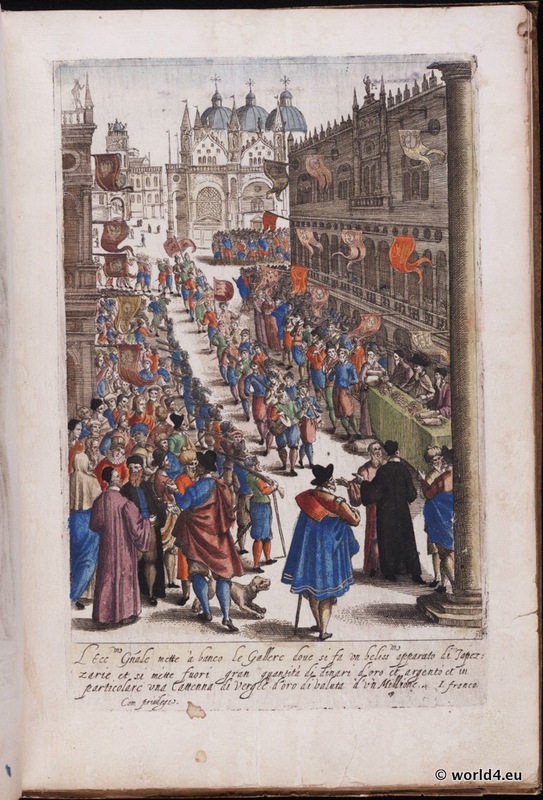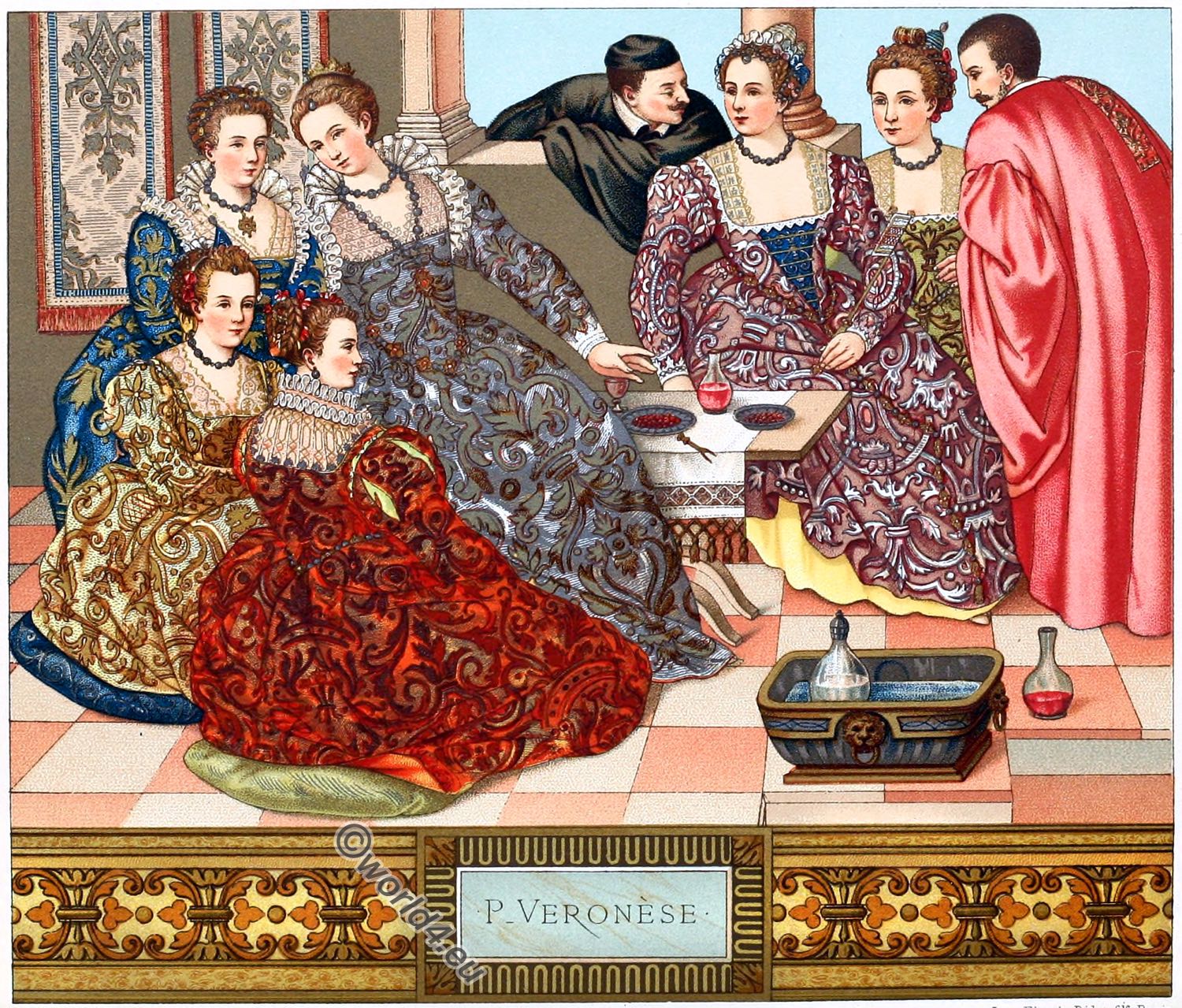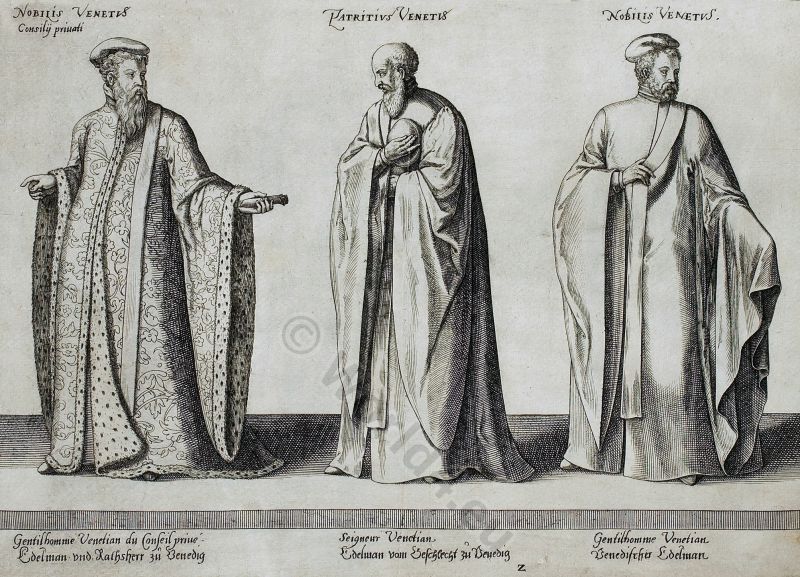
ITALY. THE VENETIAN GONDOLIERS; XV. AND XVI. CENTURY. PAGES, DWARFS AND COURT JESTERS; XIV. AND XVIII. CENTURY.
THE CASTELLANI GONDOLIER.
During the time of Phillippe de Comines, there were 30000 gondolas in Venice. The gondoliers in service of the doge and the nobility wore the livery of their lords. Among the others, there were the Nicolotti, the dark ones, and the Castellani, the red-dressed ones, colours that were also used as insignia for the inhabitants of the right and left banks of the Grand Canal.
Towards the end of the Middle Ages in Venice, the gondolas were objects of a great luxury that was tried to limit by special laws. The state barques of the nobility were usually manned with two, the rented gondolas with one gondolier.
No. 3 and 4. Gondoliers landing on a quay. Everyday costume; end of the XV century. After paintings by Ludovico Menin. No. 3. Cap enclosing the head. Green doublet with red cloth hood. Belt and pocket of yellow leather. Dagger knife. Dark pants. Leather shoes. No. 4. cap of the same shape with two feathers. Shirt with wide sleeves. Waistcoat-like doublet with belt. Trousers, white on the inside, red on the outside.
Nos. 1, 2, 5 and 6: Gondolier in parade costume; after a painting of Carpaccio in the Academy of Venice.
No. 1. An African in livery. Red cap. Velvet doublet with yellow silk lapels. Same over sleeves that show the puffed shirt. Leather belt. Velvet breeches. Silk jerseys, composed of blue and white stripes. Fashion of the Mi-parti. Shoes of the same colour as the barrette and the doublet.
No. 2. cap with red feather. Silk doublet, whose slits let you see the puffs of the shirt. Tricot trousers, striped at the top, plain at the bottom.
No. 5. Red Berrettino. Blue slashed doublet. Jerseys.
No. 6. Scarlet wool cap. Silk doublet. Silk over sleeves, showing the shirt at the shoulders and elbows. Dagger in a black belt with pocket. Long red tricot trousers.
PAGE COSTUME.
Every Italian nobleman was surrounded by a retinue of young people from good families, who were under the aegis of the woman until the seventh year, when they enjoyed her martial education.
No. 9. Riding costume. After a XIV century enamel in the possession of Mr. de Cristoforis in Venice. Doublet with leather collar above. Big gaiters. Trousers, back with riding leather.
No. 7. Page in the wake of a noble lady, XVth century. The page after a painting by Carpaccio, the lady after a painting by Giovanni Bellini, both in the Academy of Venice.
The page, who carries the lady’s train, is dressed in a red velvet barret, sky-blue doublet with over sleeves, blue and white diced or striped trousers. On the grey leather belt hangs a red leather bag. Leather shoes. The lady wears her hair in a gold net. The red silk robe is garnished with lace puffs at the low neckline of the bodice. The puffed sleeves of the shirt are visible under orange over sleeves.
DWARVES AND COURT JESTERS.
After Blaise de Vigenère, dwarves served as pages and messengers of love all over Italy. As court jesters, they preferred Africans and physically handicapped people. They wore the livery of their masters with special jester badges.
No. 8. Court jester. End of the XVI century. Paintings by Paul Veronese; Gallery of the Brera, Milan. Livree in white silk with trousers in white leather or cloth. The doublet is trimmed with golden acorns with silk tassels.
No. 10. Court Dwarf. Beginning of the XVI century. Fresco by Gaudenzio Ferrari, Brera Gallery, Milan. White felt hat, hanging on the back. Yellow trousers with blue stripes. Doublet of light fabric. Large scimitar.
No. 11. court dwarf with a monkey; end of the XVI century. From a painting by Bonifazio; Gallery of the Brera, Milan. Earrings, open waistcoat in front; harem pants; stockings and slit shoes.
No. 12. Court jester. XVIII. Century. Fresco by Tiepolo, Labbia Palace, Venice. Costume similar to that worn in the youth of Louis XIV. High hat with slit bottom and serrated brim; split doublet with slit puff sleeves. Long trousers and shoes.
Watercolour von Stephan Baron. See Vecellio, Ancient and Modern Costumes, Paris 1859. – Delaporte, The French Traveller, 1782.
Source: History of the costume in chronological development by Albert Charles Auguste Racinet. Edited by Adolf Rosenberg. Berlin 1888.
Related
Discover more from World4 Costume Culture History
Subscribe to get the latest posts sent to your email.






